Carbon Capture and Storage: Impact and Application Report
VerifiedAdded on 2022/09/18
|21
|5597
|30
Report
AI Summary
This report provides a comprehensive overview of carbon capture and storage (CCS) technology. It begins with an executive summary highlighting the importance of CCS in mitigating greenhouse gas emissions, particularly carbon dioxide, and addresses the barriers to its implementation, such as regulatory issues and public acceptance. The report then delves into the current state of CCS, discussing various CO2 capture methods, including pre-combustion, oxyfuel combustion, and post-combustion techniques. It examines CO2 transport and storage options, and assesses the impact of CCS on the energy system and other fuels. The report further explores the technical development of CCS, highlighting advancements in CO2 scrubbers and oxy-combustion technologies. It identifies both barriers, such as cost competitiveness and storage options, and opportunities, including enhanced oil recovery and CCS in the power sector. The report concludes with a personal view on the technology and references relevant literature.
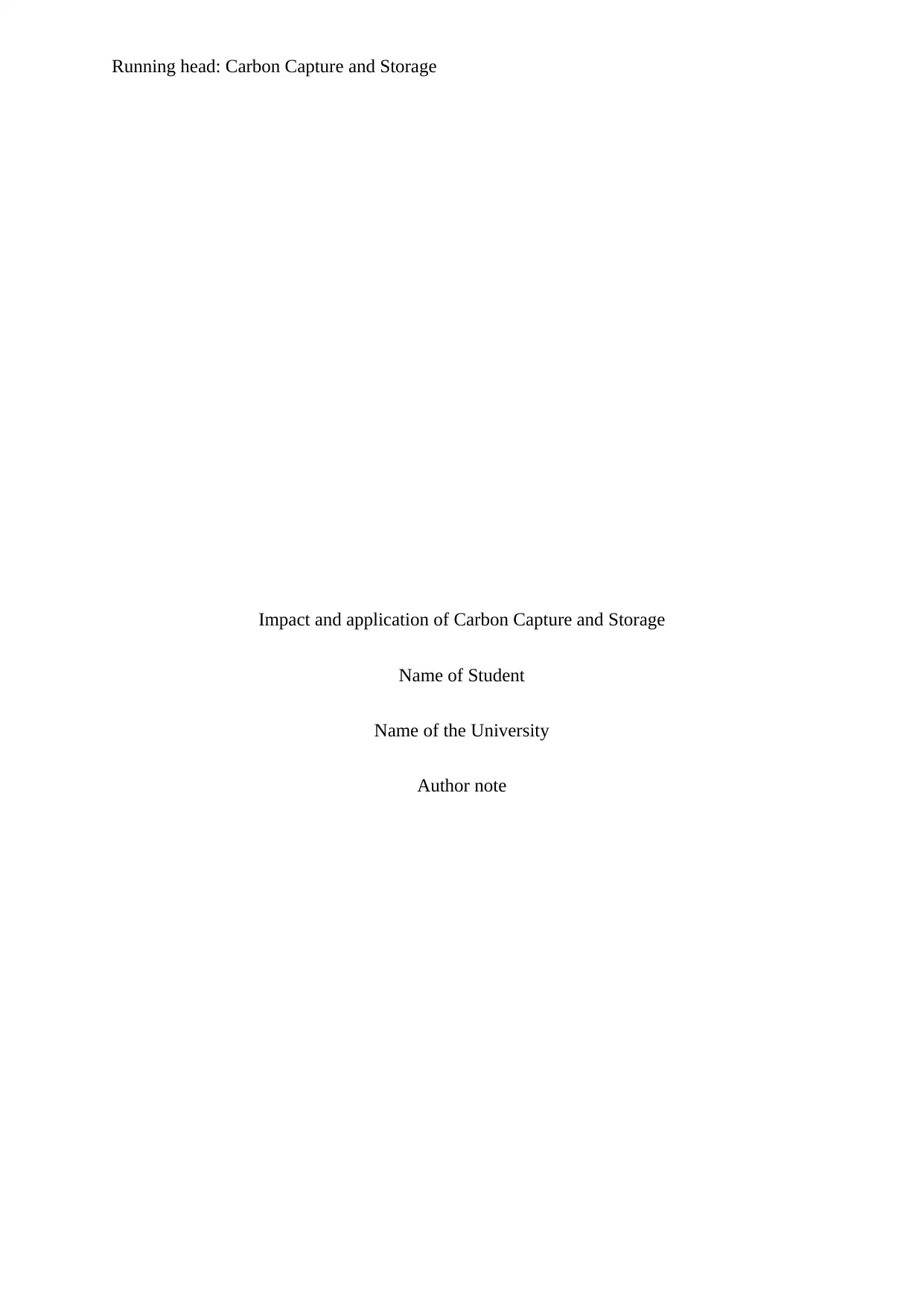
Running head: Carbon Capture and Storage
Impact and application of Carbon Capture and Storage
Name of Student
Name of the University
Author note
Impact and application of Carbon Capture and Storage
Name of Student
Name of the University
Author note
Paraphrase This Document
Need a fresh take? Get an instant paraphrase of this document with our AI Paraphraser
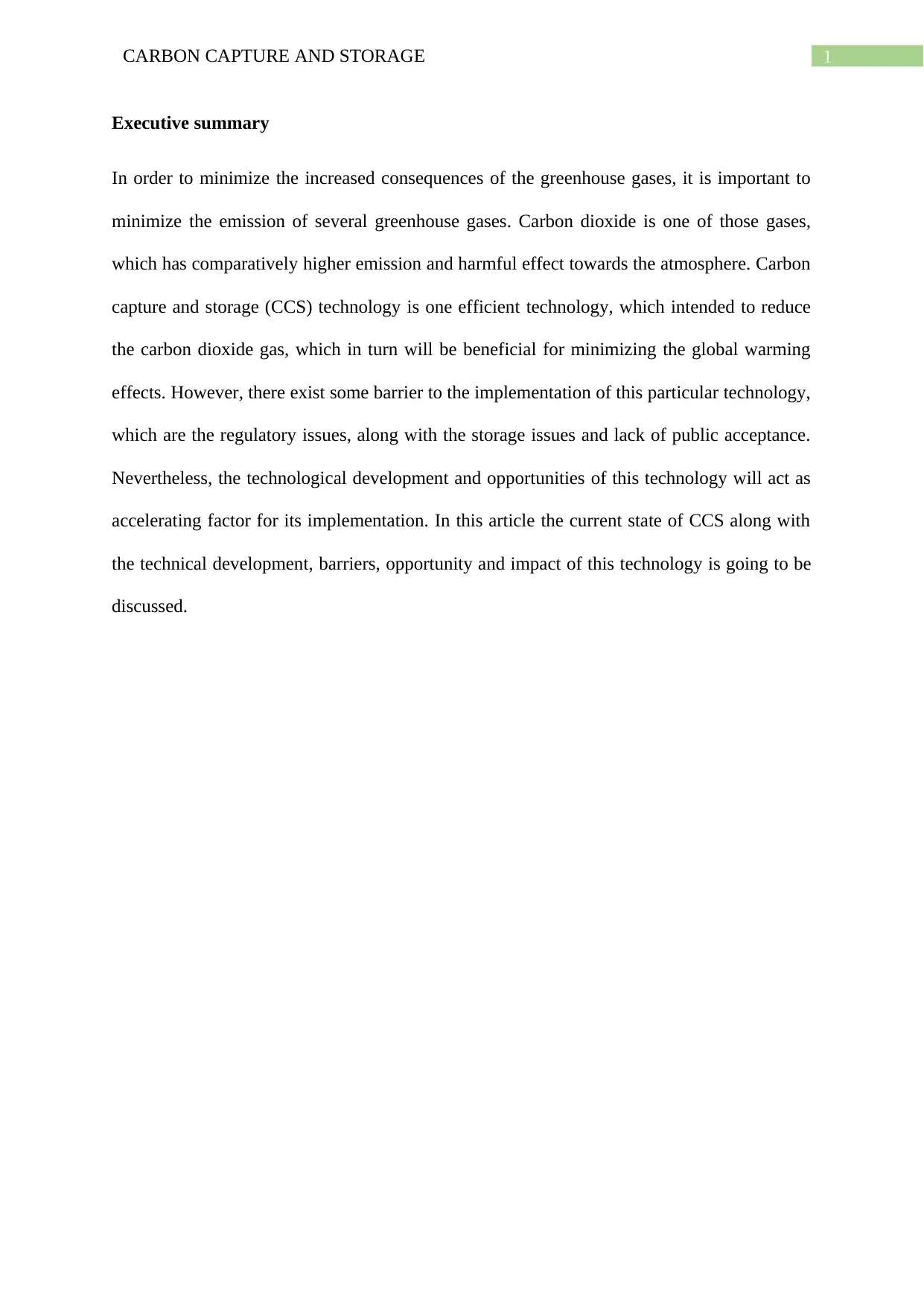
1CARBON CAPTURE AND STORAGE
Executive summary
In order to minimize the increased consequences of the greenhouse gases, it is important to
minimize the emission of several greenhouse gases. Carbon dioxide is one of those gases,
which has comparatively higher emission and harmful effect towards the atmosphere. Carbon
capture and storage (CCS) technology is one efficient technology, which intended to reduce
the carbon dioxide gas, which in turn will be beneficial for minimizing the global warming
effects. However, there exist some barrier to the implementation of this particular technology,
which are the regulatory issues, along with the storage issues and lack of public acceptance.
Nevertheless, the technological development and opportunities of this technology will act as
accelerating factor for its implementation. In this article the current state of CCS along with
the technical development, barriers, opportunity and impact of this technology is going to be
discussed.
Executive summary
In order to minimize the increased consequences of the greenhouse gases, it is important to
minimize the emission of several greenhouse gases. Carbon dioxide is one of those gases,
which has comparatively higher emission and harmful effect towards the atmosphere. Carbon
capture and storage (CCS) technology is one efficient technology, which intended to reduce
the carbon dioxide gas, which in turn will be beneficial for minimizing the global warming
effects. However, there exist some barrier to the implementation of this particular technology,
which are the regulatory issues, along with the storage issues and lack of public acceptance.
Nevertheless, the technological development and opportunities of this technology will act as
accelerating factor for its implementation. In this article the current state of CCS along with
the technical development, barriers, opportunity and impact of this technology is going to be
discussed.
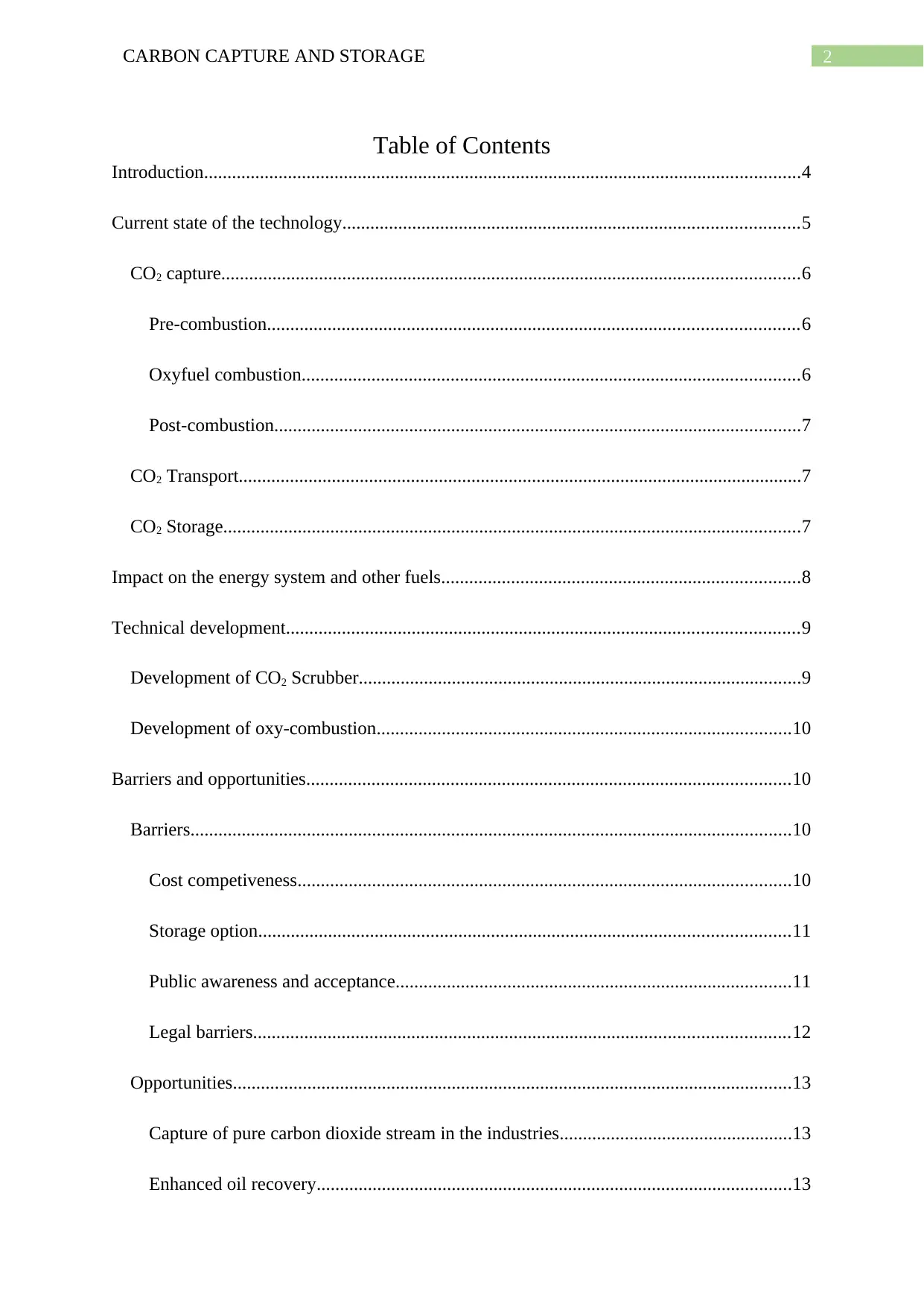
2CARBON CAPTURE AND STORAGE
Table of Contents
Introduction................................................................................................................................4
Current state of the technology..................................................................................................5
CO2 capture............................................................................................................................6
Pre-combustion..................................................................................................................6
Oxyfuel combustion...........................................................................................................6
Post-combustion.................................................................................................................7
CO2 Transport.........................................................................................................................7
CO2 Storage............................................................................................................................7
Impact on the energy system and other fuels.............................................................................8
Technical development..............................................................................................................9
Development of CO2 Scrubber...............................................................................................9
Development of oxy-combustion.........................................................................................10
Barriers and opportunities........................................................................................................10
Barriers.................................................................................................................................10
Cost competiveness..........................................................................................................10
Storage option..................................................................................................................11
Public awareness and acceptance.....................................................................................11
Legal barriers...................................................................................................................12
Opportunities........................................................................................................................13
Capture of pure carbon dioxide stream in the industries..................................................13
Enhanced oil recovery......................................................................................................13
Table of Contents
Introduction................................................................................................................................4
Current state of the technology..................................................................................................5
CO2 capture............................................................................................................................6
Pre-combustion..................................................................................................................6
Oxyfuel combustion...........................................................................................................6
Post-combustion.................................................................................................................7
CO2 Transport.........................................................................................................................7
CO2 Storage............................................................................................................................7
Impact on the energy system and other fuels.............................................................................8
Technical development..............................................................................................................9
Development of CO2 Scrubber...............................................................................................9
Development of oxy-combustion.........................................................................................10
Barriers and opportunities........................................................................................................10
Barriers.................................................................................................................................10
Cost competiveness..........................................................................................................10
Storage option..................................................................................................................11
Public awareness and acceptance.....................................................................................11
Legal barriers...................................................................................................................12
Opportunities........................................................................................................................13
Capture of pure carbon dioxide stream in the industries..................................................13
Enhanced oil recovery......................................................................................................13
⊘ This is a preview!⊘
Do you want full access?
Subscribe today to unlock all pages.

Trusted by 1+ million students worldwide

3CARBON CAPTURE AND STORAGE
CCS technology in power and coal sector.......................................................................13
Personal view on the technology..............................................................................................14
Conclusion................................................................................................................................14
Reference..................................................................................................................................16
CCS technology in power and coal sector.......................................................................13
Personal view on the technology..............................................................................................14
Conclusion................................................................................................................................14
Reference..................................................................................................................................16
Paraphrase This Document
Need a fresh take? Get an instant paraphrase of this document with our AI Paraphraser

4CARBON CAPTURE AND STORAGE
Introduction
Ever since the industrialization has happened, a hike in the method of burning of the
fossil fuels in order to acquire the desired energy demands have come into consideration. The
utilization of these fuels is responsible for high emission of the carbon dioxide (CO2) and
several different dangerous greenhouse gases that can cause global warming (Boot-Handford
et al. 2014). Moreover, these type of hazardous situations will definitely have injurious
impact on the Earth. However, one successful way for alleviating this issue is to minimize the
utilization of these fuels. Nevertheless, one alternative method to this issue might be the
capture and store of the emitted carbon, so that the atmosphere become safe from pollution.
The process of carbon capture and storage (CCS) is one of the existing range of technological
energy strategies or solutions to address all the concerns related to the increasing emission of
different greenhouse gas present the atmosphere (Selma et al. 2014). The particular process is
also beneficial in achieving sustainable energy from the use of the fossil fuel. There exist
three important techniques, which are pre-combustion, post-combustion and oxyfuel process
that enhances the CCS process. Moreover, using the CCS with several renewable biomass
can be identified as one carbon abatement technology, that will be utilized in the ‘carbon-
negative' mode , which is not different from taking the dangerous carbon dioxide out of the
atmosphere (Tola and Pettinau 2014).
This report is going to discuss the current state of the carbon capture and storage in
the United Kingdom, along with the impact of the technology on the energy system as well as
on other fuels. The current as well as future technical development of CCS is going to be
focused here. In addition to that, the existing opportunities and barriers to the particular
technologies is going to be emphasized here.
Introduction
Ever since the industrialization has happened, a hike in the method of burning of the
fossil fuels in order to acquire the desired energy demands have come into consideration. The
utilization of these fuels is responsible for high emission of the carbon dioxide (CO2) and
several different dangerous greenhouse gases that can cause global warming (Boot-Handford
et al. 2014). Moreover, these type of hazardous situations will definitely have injurious
impact on the Earth. However, one successful way for alleviating this issue is to minimize the
utilization of these fuels. Nevertheless, one alternative method to this issue might be the
capture and store of the emitted carbon, so that the atmosphere become safe from pollution.
The process of carbon capture and storage (CCS) is one of the existing range of technological
energy strategies or solutions to address all the concerns related to the increasing emission of
different greenhouse gas present the atmosphere (Selma et al. 2014). The particular process is
also beneficial in achieving sustainable energy from the use of the fossil fuel. There exist
three important techniques, which are pre-combustion, post-combustion and oxyfuel process
that enhances the CCS process. Moreover, using the CCS with several renewable biomass
can be identified as one carbon abatement technology, that will be utilized in the ‘carbon-
negative' mode , which is not different from taking the dangerous carbon dioxide out of the
atmosphere (Tola and Pettinau 2014).
This report is going to discuss the current state of the carbon capture and storage in
the United Kingdom, along with the impact of the technology on the energy system as well as
on other fuels. The current as well as future technical development of CCS is going to be
focused here. In addition to that, the existing opportunities and barriers to the particular
technologies is going to be emphasized here.
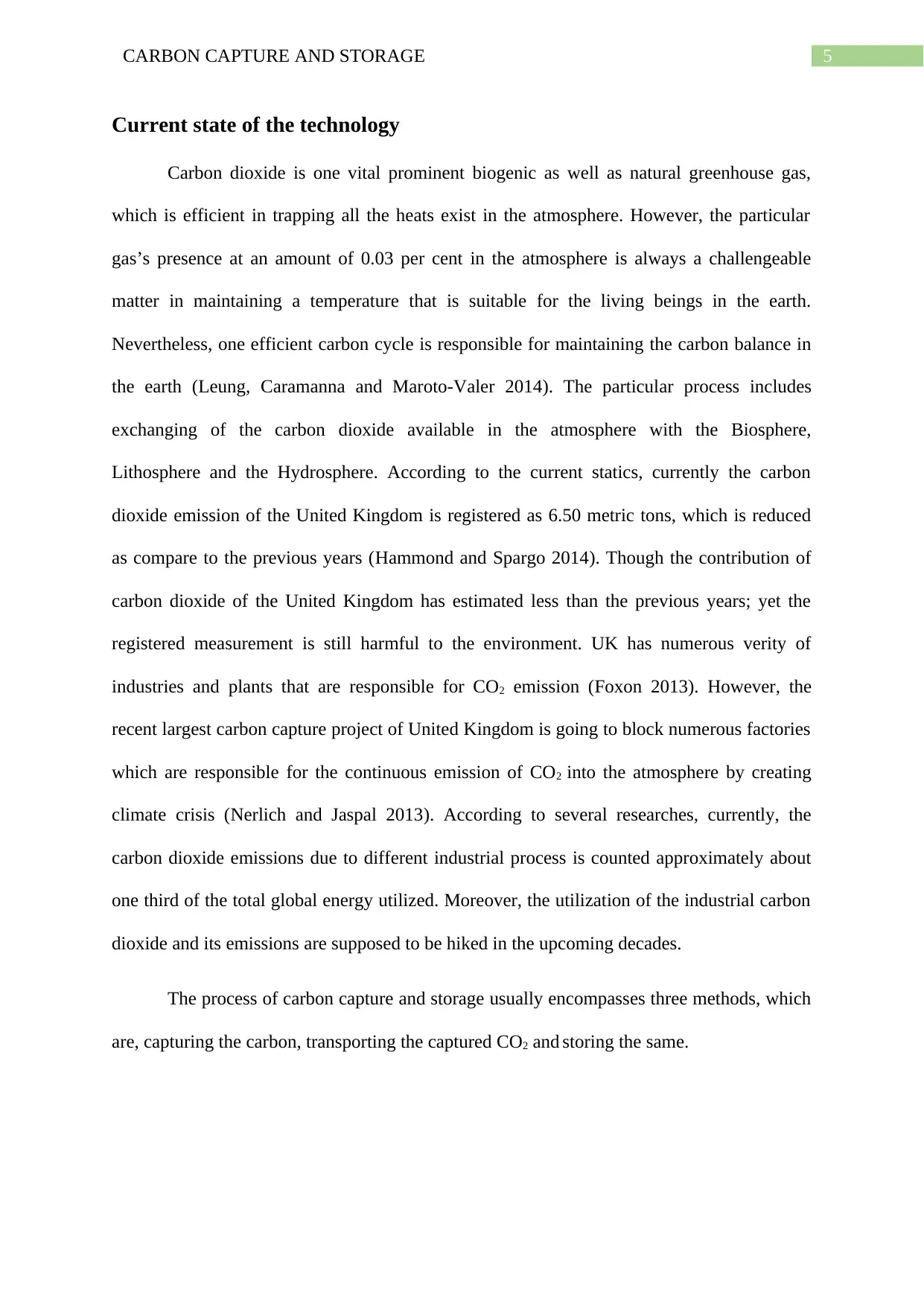
5CARBON CAPTURE AND STORAGE
Current state of the technology
Carbon dioxide is one vital prominent biogenic as well as natural greenhouse gas,
which is efficient in trapping all the heats exist in the atmosphere. However, the particular
gas’s presence at an amount of 0.03 per cent in the atmosphere is always a challengeable
matter in maintaining a temperature that is suitable for the living beings in the earth.
Nevertheless, one efficient carbon cycle is responsible for maintaining the carbon balance in
the earth (Leung, Caramanna and Maroto-Valer 2014). The particular process includes
exchanging of the carbon dioxide available in the atmosphere with the Biosphere,
Lithosphere and the Hydrosphere. According to the current statics, currently the carbon
dioxide emission of the United Kingdom is registered as 6.50 metric tons, which is reduced
as compare to the previous years (Hammond and Spargo 2014). Though the contribution of
carbon dioxide of the United Kingdom has estimated less than the previous years; yet the
registered measurement is still harmful to the environment. UK has numerous verity of
industries and plants that are responsible for CO2 emission (Foxon 2013). However, the
recent largest carbon capture project of United Kingdom is going to block numerous factories
which are responsible for the continuous emission of CO2 into the atmosphere by creating
climate crisis (Nerlich and Jaspal 2013). According to several researches, currently, the
carbon dioxide emissions due to different industrial process is counted approximately about
one third of the total global energy utilized. Moreover, the utilization of the industrial carbon
dioxide and its emissions are supposed to be hiked in the upcoming decades.
The process of carbon capture and storage usually encompasses three methods, which
are, capturing the carbon, transporting the captured CO2 and storing the same.
Current state of the technology
Carbon dioxide is one vital prominent biogenic as well as natural greenhouse gas,
which is efficient in trapping all the heats exist in the atmosphere. However, the particular
gas’s presence at an amount of 0.03 per cent in the atmosphere is always a challengeable
matter in maintaining a temperature that is suitable for the living beings in the earth.
Nevertheless, one efficient carbon cycle is responsible for maintaining the carbon balance in
the earth (Leung, Caramanna and Maroto-Valer 2014). The particular process includes
exchanging of the carbon dioxide available in the atmosphere with the Biosphere,
Lithosphere and the Hydrosphere. According to the current statics, currently the carbon
dioxide emission of the United Kingdom is registered as 6.50 metric tons, which is reduced
as compare to the previous years (Hammond and Spargo 2014). Though the contribution of
carbon dioxide of the United Kingdom has estimated less than the previous years; yet the
registered measurement is still harmful to the environment. UK has numerous verity of
industries and plants that are responsible for CO2 emission (Foxon 2013). However, the
recent largest carbon capture project of United Kingdom is going to block numerous factories
which are responsible for the continuous emission of CO2 into the atmosphere by creating
climate crisis (Nerlich and Jaspal 2013). According to several researches, currently, the
carbon dioxide emissions due to different industrial process is counted approximately about
one third of the total global energy utilized. Moreover, the utilization of the industrial carbon
dioxide and its emissions are supposed to be hiked in the upcoming decades.
The process of carbon capture and storage usually encompasses three methods, which
are, capturing the carbon, transporting the captured CO2 and storing the same.
⊘ This is a preview!⊘
Do you want full access?
Subscribe today to unlock all pages.

Trusted by 1+ million students worldwide

6CARBON CAPTURE AND STORAGE
CO2 capture
Capturing the carbon is one vital step in the entire process of CCS. The total amount
of carbon dioxide present in the atmosphere can efficiently captured at the exact locations
where it is generated, for example, the industrial units or thermal power plants (Nykvist
2013). Capturing the carbon dioxide using several biological, physical and chemical
techniques can be adapted to several fields such as, the gas processing industries, steel plants,
ammonia, cement works, power plant, and different refineries (de Coninck and Benson
2014). However, basically the capturing of the CO2 is the process of separation of the carbon
dioxide apart from other gases, which are generated due to wide industrial process. This
separation process can be done using three methods, which are, pre-combustion, oxyfuel
combustion and the post combustion.
Pre-combustion: This process includes the gasification of several fuels such as coal. In this
process the fuel perform a reaction with the steam so that it can be converted into the carbon
monoxide and hydrogen, and this particular method is named as the synthesis gas mixture
(Theo et al. 2016). However, one limitation to the pre-combustion process is that, the
particular process cannot be retro-fitted into older pulverised power plants. Nevertheless, it
can be utilized into the gas stations. Despite of having many benefits, the economic
advantage related to this particular method over the post-combustion has not proven yet
(Babu et al. 2015).
Oxyfuel combustion: Oxyfuel separation can be considered as the most advanced method of
carbon dioxide capture. The process starts when a fuel gets burnt in the air and the emitted
carbon dioxide combines with other existing components of the air (Cormos 2016).
Separating the CO2 using this method includes filling of combustion chamber with pure
oxygen. Furthermore, this process is carried out by using the air separation unit that performs
on the principle of cryogenic (Adánez-Rubio et al. 2014).
CO2 capture
Capturing the carbon is one vital step in the entire process of CCS. The total amount
of carbon dioxide present in the atmosphere can efficiently captured at the exact locations
where it is generated, for example, the industrial units or thermal power plants (Nykvist
2013). Capturing the carbon dioxide using several biological, physical and chemical
techniques can be adapted to several fields such as, the gas processing industries, steel plants,
ammonia, cement works, power plant, and different refineries (de Coninck and Benson
2014). However, basically the capturing of the CO2 is the process of separation of the carbon
dioxide apart from other gases, which are generated due to wide industrial process. This
separation process can be done using three methods, which are, pre-combustion, oxyfuel
combustion and the post combustion.
Pre-combustion: This process includes the gasification of several fuels such as coal. In this
process the fuel perform a reaction with the steam so that it can be converted into the carbon
monoxide and hydrogen, and this particular method is named as the synthesis gas mixture
(Theo et al. 2016). However, one limitation to the pre-combustion process is that, the
particular process cannot be retro-fitted into older pulverised power plants. Nevertheless, it
can be utilized into the gas stations. Despite of having many benefits, the economic
advantage related to this particular method over the post-combustion has not proven yet
(Babu et al. 2015).
Oxyfuel combustion: Oxyfuel separation can be considered as the most advanced method of
carbon dioxide capture. The process starts when a fuel gets burnt in the air and the emitted
carbon dioxide combines with other existing components of the air (Cormos 2016).
Separating the CO2 using this method includes filling of combustion chamber with pure
oxygen. Furthermore, this process is carried out by using the air separation unit that performs
on the principle of cryogenic (Adánez-Rubio et al. 2014).
Paraphrase This Document
Need a fresh take? Get an instant paraphrase of this document with our AI Paraphraser

7CARBON CAPTURE AND STORAGE
Post-combustion: Under the process of post-combustion, the carbon dioxide gets separated
from the associated flue gas by bubbling the particular gas via one absorber column, which is
packed with the liquid solvents and this is responsible for separating the carbon dioxide
(Liang et al. 2015). In addition to that, some more experimental techniques for separating the
CO2 from all the flue gas avoiding the two-step process involves the utilization of seawater
for absorbing the gas and returning the previous mixture to the ocean for storage (Huck et al.
2014 ).
CO2 Transport
After completion of the CO2, the same need to be transported to the storage sites.
However, the transport of CO2 cannot be stated as one scientific problem, rather, ships as
well as pipelines are considered to be the prominent ways for long distance transportation of
the CO2 (Rodrigues et al. 2015).
CO2 Storage
The transported CO2 is stored in the chosen geographical area or rock formation,
situated in many kilometre below the earth surface. Moreover, for the geological storage, the
carbon dioxide gets injected under the ground in different geological environments in the
sedimentary basin. Apart from that, several other potential storage sites for the storage as well
as sequestration of the CO2 involves organic shale, basalt rocks and caverns (Seidl et al.
2014).
However, there can be two situations where the process of CCS can be applied and
demonstrated UK based industries or the industries exist around the globe in a quick manner.
Firstly, because the process of carbon dioxide emissions are considered to be inherent to the
industrial processes; therefore, it is economically and technically difficult to minimize the
CO2 emissions in the industry, rather than in different sectors. Hence, in such situation, the
Post-combustion: Under the process of post-combustion, the carbon dioxide gets separated
from the associated flue gas by bubbling the particular gas via one absorber column, which is
packed with the liquid solvents and this is responsible for separating the carbon dioxide
(Liang et al. 2015). In addition to that, some more experimental techniques for separating the
CO2 from all the flue gas avoiding the two-step process involves the utilization of seawater
for absorbing the gas and returning the previous mixture to the ocean for storage (Huck et al.
2014 ).
CO2 Transport
After completion of the CO2, the same need to be transported to the storage sites.
However, the transport of CO2 cannot be stated as one scientific problem, rather, ships as
well as pipelines are considered to be the prominent ways for long distance transportation of
the CO2 (Rodrigues et al. 2015).
CO2 Storage
The transported CO2 is stored in the chosen geographical area or rock formation,
situated in many kilometre below the earth surface. Moreover, for the geological storage, the
carbon dioxide gets injected under the ground in different geological environments in the
sedimentary basin. Apart from that, several other potential storage sites for the storage as well
as sequestration of the CO2 involves organic shale, basalt rocks and caverns (Seidl et al.
2014).
However, there can be two situations where the process of CCS can be applied and
demonstrated UK based industries or the industries exist around the globe in a quick manner.
Firstly, because the process of carbon dioxide emissions are considered to be inherent to the
industrial processes; therefore, it is economically and technically difficult to minimize the
CO2 emissions in the industry, rather than in different sectors. Hence, in such situation, the

8CARBON CAPTURE AND STORAGE
CCS as one mitigation option in the industries turned as the single options for the large scale
emissions degradation. Whereas, the second situation explains that, some of the UK based
industry vent more purity carbon dioxide to the atmosphere. These pure resources of the
carbon dioxide can become cost efficient in capturing the CO2. This particular process can
create early opportunity for demonstrating the CCS.
Impact on the energy system and other fuels
The energy system is typically explained as a system that is primarily designed for
supplying energy services to the end users. Moreover, analysing the energy system
structurally, it can be said that, in the particular system every single component is related to
the production of the energy along with its conversion, delivery and utilization (Mac Dowell
and Staffell 2016). As per the research conducted by Energy Technology Institute (ETI)
explains that, the CCS is efficient in delivering about 15% decrease in selling cost of the
electricity. The degradation in the electricity cost is definitely crucial, as the particular step
not only turned out to be beneficial for householders, but also it accelerate the maintenance of
the energy in several UK based manufacturing industries (Huaman and Jun 2014).
Furthermore, it will safeguard the cost of different service and goods produced in the
geographical region of United Kingdom. In addition to that, the process of carbon capture and
storage enables the rigorous utilization of all the available energy production, generation
infrastructure and transport, which on other hand, slower the retirement of many important
assets and discards the continuous increase in the production cost. Apart from that, the CCS
acts as one efficient player in the mixed energy portfolio, which involves hike in the quantity
of nuclear power and wind (Parkhill et al. 2013). This scenario is helpful in giving an
effective dispatchable back up load, and thereby helping the migration against the
inflexibility of the nuclear and wind power. In addition to that, the technology of capturing as
well as storing the existing carbon dioxide in the atmosphere is recently the only single way
CCS as one mitigation option in the industries turned as the single options for the large scale
emissions degradation. Whereas, the second situation explains that, some of the UK based
industry vent more purity carbon dioxide to the atmosphere. These pure resources of the
carbon dioxide can become cost efficient in capturing the CO2. This particular process can
create early opportunity for demonstrating the CCS.
Impact on the energy system and other fuels
The energy system is typically explained as a system that is primarily designed for
supplying energy services to the end users. Moreover, analysing the energy system
structurally, it can be said that, in the particular system every single component is related to
the production of the energy along with its conversion, delivery and utilization (Mac Dowell
and Staffell 2016). As per the research conducted by Energy Technology Institute (ETI)
explains that, the CCS is efficient in delivering about 15% decrease in selling cost of the
electricity. The degradation in the electricity cost is definitely crucial, as the particular step
not only turned out to be beneficial for householders, but also it accelerate the maintenance of
the energy in several UK based manufacturing industries (Huaman and Jun 2014).
Furthermore, it will safeguard the cost of different service and goods produced in the
geographical region of United Kingdom. In addition to that, the process of carbon capture and
storage enables the rigorous utilization of all the available energy production, generation
infrastructure and transport, which on other hand, slower the retirement of many important
assets and discards the continuous increase in the production cost. Apart from that, the CCS
acts as one efficient player in the mixed energy portfolio, which involves hike in the quantity
of nuclear power and wind (Parkhill et al. 2013). This scenario is helpful in giving an
effective dispatchable back up load, and thereby helping the migration against the
inflexibility of the nuclear and wind power. In addition to that, the technology of capturing as
well as storing the existing carbon dioxide in the atmosphere is recently the only single way
⊘ This is a preview!⊘
Do you want full access?
Subscribe today to unlock all pages.

Trusted by 1+ million students worldwide
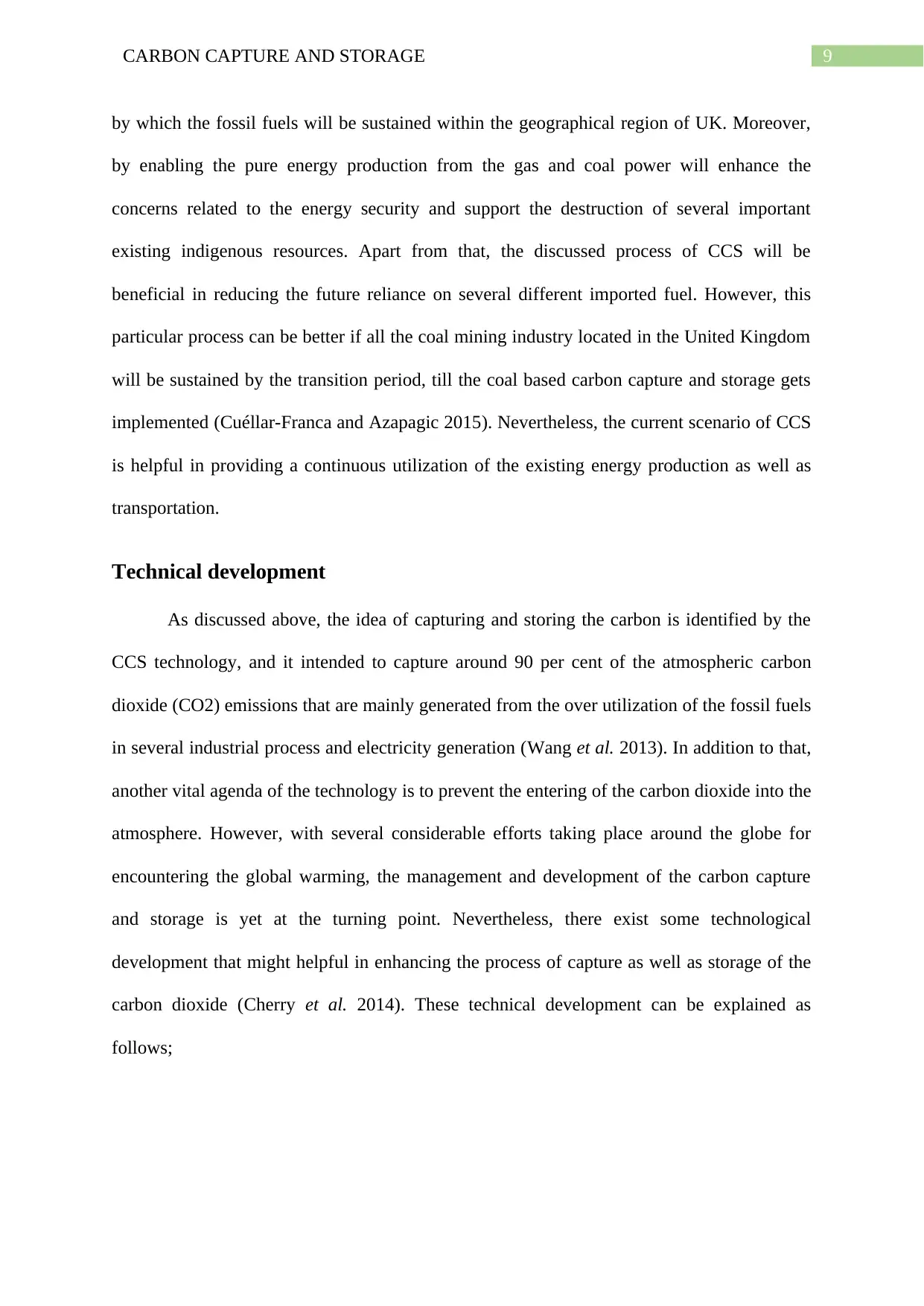
9CARBON CAPTURE AND STORAGE
by which the fossil fuels will be sustained within the geographical region of UK. Moreover,
by enabling the pure energy production from the gas and coal power will enhance the
concerns related to the energy security and support the destruction of several important
existing indigenous resources. Apart from that, the discussed process of CCS will be
beneficial in reducing the future reliance on several different imported fuel. However, this
particular process can be better if all the coal mining industry located in the United Kingdom
will be sustained by the transition period, till the coal based carbon capture and storage gets
implemented (Cuéllar-Franca and Azapagic 2015). Nevertheless, the current scenario of CCS
is helpful in providing a continuous utilization of the existing energy production as well as
transportation.
Technical development
As discussed above, the idea of capturing and storing the carbon is identified by the
CCS technology, and it intended to capture around 90 per cent of the atmospheric carbon
dioxide (CO2) emissions that are mainly generated from the over utilization of the fossil fuels
in several industrial process and electricity generation (Wang et al. 2013). In addition to that,
another vital agenda of the technology is to prevent the entering of the carbon dioxide into the
atmosphere. However, with several considerable efforts taking place around the globe for
encountering the global warming, the management and development of the carbon capture
and storage is yet at the turning point. Nevertheless, there exist some technological
development that might helpful in enhancing the process of capture as well as storage of the
carbon dioxide (Cherry et al. 2014). These technical development can be explained as
follows;
by which the fossil fuels will be sustained within the geographical region of UK. Moreover,
by enabling the pure energy production from the gas and coal power will enhance the
concerns related to the energy security and support the destruction of several important
existing indigenous resources. Apart from that, the discussed process of CCS will be
beneficial in reducing the future reliance on several different imported fuel. However, this
particular process can be better if all the coal mining industry located in the United Kingdom
will be sustained by the transition period, till the coal based carbon capture and storage gets
implemented (Cuéllar-Franca and Azapagic 2015). Nevertheless, the current scenario of CCS
is helpful in providing a continuous utilization of the existing energy production as well as
transportation.
Technical development
As discussed above, the idea of capturing and storing the carbon is identified by the
CCS technology, and it intended to capture around 90 per cent of the atmospheric carbon
dioxide (CO2) emissions that are mainly generated from the over utilization of the fossil fuels
in several industrial process and electricity generation (Wang et al. 2013). In addition to that,
another vital agenda of the technology is to prevent the entering of the carbon dioxide into the
atmosphere. However, with several considerable efforts taking place around the globe for
encountering the global warming, the management and development of the carbon capture
and storage is yet at the turning point. Nevertheless, there exist some technological
development that might helpful in enhancing the process of capture as well as storage of the
carbon dioxide (Cherry et al. 2014). These technical development can be explained as
follows;
Paraphrase This Document
Need a fresh take? Get an instant paraphrase of this document with our AI Paraphraser
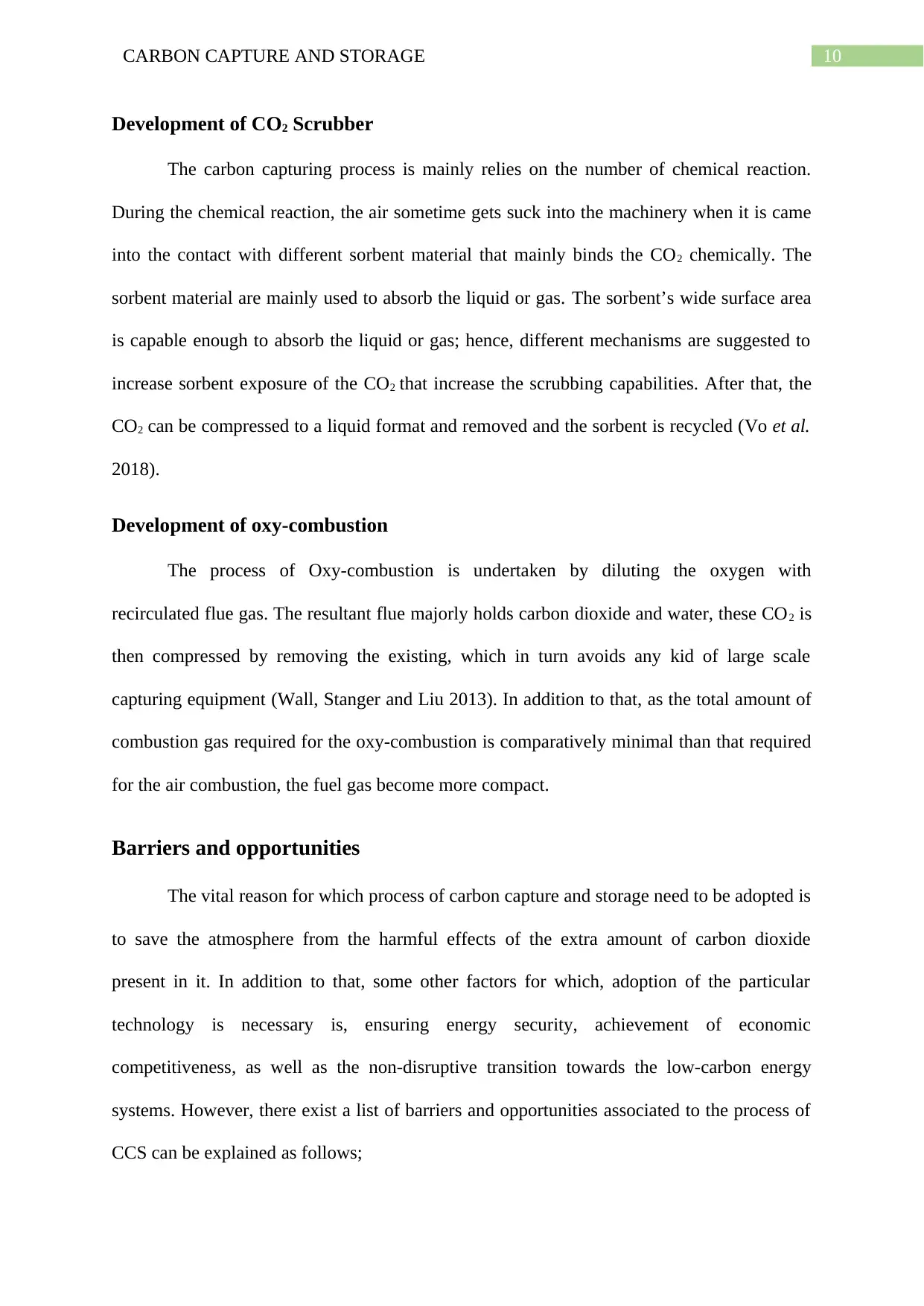
10CARBON CAPTURE AND STORAGE
Development of CO2 Scrubber
The carbon capturing process is mainly relies on the number of chemical reaction.
During the chemical reaction, the air sometime gets suck into the machinery when it is came
into the contact with different sorbent material that mainly binds the CO2 chemically. The
sorbent material are mainly used to absorb the liquid or gas. The sorbent’s wide surface area
is capable enough to absorb the liquid or gas; hence, different mechanisms are suggested to
increase sorbent exposure of the CO2 that increase the scrubbing capabilities. After that, the
CO2 can be compressed to a liquid format and removed and the sorbent is recycled (Vo et al.
2018).
Development of oxy-combustion
The process of Oxy-combustion is undertaken by diluting the oxygen with
recirculated flue gas. The resultant flue majorly holds carbon dioxide and water, these CO2 is
then compressed by removing the existing, which in turn avoids any kid of large scale
capturing equipment (Wall, Stanger and Liu 2013). In addition to that, as the total amount of
combustion gas required for the oxy-combustion is comparatively minimal than that required
for the air combustion, the fuel gas become more compact.
Barriers and opportunities
The vital reason for which process of carbon capture and storage need to be adopted is
to save the atmosphere from the harmful effects of the extra amount of carbon dioxide
present in it. In addition to that, some other factors for which, adoption of the particular
technology is necessary is, ensuring energy security, achievement of economic
competitiveness, as well as the non-disruptive transition towards the low-carbon energy
systems. However, there exist a list of barriers and opportunities associated to the process of
CCS can be explained as follows;
Development of CO2 Scrubber
The carbon capturing process is mainly relies on the number of chemical reaction.
During the chemical reaction, the air sometime gets suck into the machinery when it is came
into the contact with different sorbent material that mainly binds the CO2 chemically. The
sorbent material are mainly used to absorb the liquid or gas. The sorbent’s wide surface area
is capable enough to absorb the liquid or gas; hence, different mechanisms are suggested to
increase sorbent exposure of the CO2 that increase the scrubbing capabilities. After that, the
CO2 can be compressed to a liquid format and removed and the sorbent is recycled (Vo et al.
2018).
Development of oxy-combustion
The process of Oxy-combustion is undertaken by diluting the oxygen with
recirculated flue gas. The resultant flue majorly holds carbon dioxide and water, these CO2 is
then compressed by removing the existing, which in turn avoids any kid of large scale
capturing equipment (Wall, Stanger and Liu 2013). In addition to that, as the total amount of
combustion gas required for the oxy-combustion is comparatively minimal than that required
for the air combustion, the fuel gas become more compact.
Barriers and opportunities
The vital reason for which process of carbon capture and storage need to be adopted is
to save the atmosphere from the harmful effects of the extra amount of carbon dioxide
present in it. In addition to that, some other factors for which, adoption of the particular
technology is necessary is, ensuring energy security, achievement of economic
competitiveness, as well as the non-disruptive transition towards the low-carbon energy
systems. However, there exist a list of barriers and opportunities associated to the process of
CCS can be explained as follows;

11CARBON CAPTURE AND STORAGE
Barriers
The key barriers to the implementation and development of the process of carbon capture and
storage are as follows;
Cost competiveness
The estimated Cost of the CCS has emerged as one major hurdle, which slower the
adoption of this particular technology. However, a clear estimation of the actual cost of the
technology and expressing the same in a transparent way is actually challenging. The vital
reason behind this is might be the lack of existing empirical data (Davies, Uchitel and Ruple
2013). In addition to that, the other reason that creates barrier to the cost effectiveness of the
efficient technology might be, facing complicacy in selecting the baseline while comparing
several CCS plants, cost differences because of the lack of transport as well as storage
infrastructure along with series of different processes involved in the capture operation
processes. Apart from this, the equipment used in the carbon capture process is sometime cost
higher depending upon the complexity of the particular process.
Storage option
Absence of effective pressure management strategies can limit the storage place or
reservoir of the carbon dioxide. Furthermore, the reservoir simulation process explains that,
only 0.01–1% in volume of the saline aquifers can be present for the carbon storage.
However, the essential existing storage capacity has underpinned through the potential
utilization of available gas and oil fields (Wennersten, Sun and Li 2015). Hence, the reservoir
pressurisations are more likely to create several potential barriers for the carbon storage.
Apart from that, one more fact that is associated with the CCS technology is that, it has
several detractors sustaining, which explains that, it might be the reason for ground water
leakage, earthquakes, which might create dangerous environmental.
Barriers
The key barriers to the implementation and development of the process of carbon capture and
storage are as follows;
Cost competiveness
The estimated Cost of the CCS has emerged as one major hurdle, which slower the
adoption of this particular technology. However, a clear estimation of the actual cost of the
technology and expressing the same in a transparent way is actually challenging. The vital
reason behind this is might be the lack of existing empirical data (Davies, Uchitel and Ruple
2013). In addition to that, the other reason that creates barrier to the cost effectiveness of the
efficient technology might be, facing complicacy in selecting the baseline while comparing
several CCS plants, cost differences because of the lack of transport as well as storage
infrastructure along with series of different processes involved in the capture operation
processes. Apart from this, the equipment used in the carbon capture process is sometime cost
higher depending upon the complexity of the particular process.
Storage option
Absence of effective pressure management strategies can limit the storage place or
reservoir of the carbon dioxide. Furthermore, the reservoir simulation process explains that,
only 0.01–1% in volume of the saline aquifers can be present for the carbon storage.
However, the essential existing storage capacity has underpinned through the potential
utilization of available gas and oil fields (Wennersten, Sun and Li 2015). Hence, the reservoir
pressurisations are more likely to create several potential barriers for the carbon storage.
Apart from that, one more fact that is associated with the CCS technology is that, it has
several detractors sustaining, which explains that, it might be the reason for ground water
leakage, earthquakes, which might create dangerous environmental.
⊘ This is a preview!⊘
Do you want full access?
Subscribe today to unlock all pages.

Trusted by 1+ million students worldwide
1 out of 21
Related Documents
Your All-in-One AI-Powered Toolkit for Academic Success.
+13062052269
info@desklib.com
Available 24*7 on WhatsApp / Email
![[object Object]](/_next/static/media/star-bottom.7253800d.svg)
Unlock your academic potential
Copyright © 2020–2025 A2Z Services. All Rights Reserved. Developed and managed by ZUCOL.





